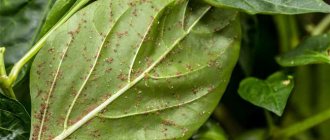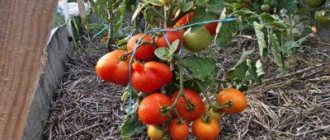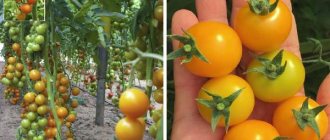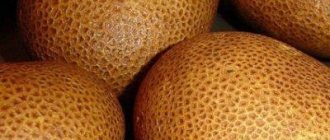Description of the Fat Jack tomato, its main characteristics and reviews of those who grew the variety
In their garden beds, vegetable growers try to plant tomato varieties with different ripening periods. The requirements for them are different, but early varieties, according to summer residents, should be unpretentious and bear good fruit.
When choosing varieties, it is very easy to make a mistake and choose a tomato that you don’t really like with its characteristics, because at present the choice is very large. Many people try to rely on reviews from gardeners who have already grown the variety they are interested in on their site.
This article talks about the early-ripening, productive Fat Jack tomato, its main characteristics, the nuances of growing it, and provides reviews from summer residents who have already planted it.
The content of the article:
1. History of the creation of the variety 2. Tomato Fat Jack: description of the variety 3. Main characteristics 4. Productivity 5. Area of application of the fruit 6. Diseases and pests of tomato crops 7. Advantages of the variety 8. Planting of the Tomato Fat Jack and further cultivation of the variety 8.1 Preparation of seed material 8.2 Preparing the soil and containers 8.3 Sowing Fat Jack tomato seeds for seedlings 8.4 Caring for tomato seedlings 8.5 Transplanting Fat Jack tomato seedlings into open ground and a greenhouse 9. Further care 9.1 Watering rules 9.2 How to feed tomatoes 10. Reviews of the Fat Jack tomato
Possible diseases and pests, ways to get rid of them
The Fat Jack tomato, reviews of which confirm its productivity, has strong immunity.
But with frequent mistakes in care or planting in the wrong place, the plant’s protection weakens, and it can be affected by the following diseases and pests:
| Name | Symptoms | Fighting methods |
| Powdery mildew | The disease develops in conditions of high humidity and low temperature. It can be recognized by a white coating, reminiscent of dust or flour in structure. | If the disease has just appeared, then you can treat the bed with garlic infusion, potassium permanganate or copper sulfate solution. If the disease is advanced, then it is better to use the fungicides “Topaz” and “Skor”. |
| Late blight | First, dark spots with a white border form on the leaves. On the reverse side they are covered with a gray coating. Over time, the shoots become covered with stripes and gradually dry out. | All affected leaves must be removed. Treat plants and soil with copper-containing preparations (Bordeaux mixture, copper sulfate). Among the folk remedies, a solution prepared from whey and water mixed in equal parts helps. |
| Whiteflies | Small flies with white wings. It can be recognized by the glossy coating that forms on the leaves. | Adult flies are easier to catch using sticky traps. To get rid of the larvae, the planting should be treated with the insecticides “Confidor” and “Karbofos”. |
| Colorado beetles | Large insects with a characteristic striped color. Beetles and larvae feed on leaves and stems and ruin most of the crop. | If there are few pests, then it is better to collect them by hand and dust the planting with wood ash. You can also use tobacco solution. For a large colony, it is advisable to use the insecticides “Commander”, “Bombardier”, “Prestige”. |
| Spider mites | Pests are difficult to see due to their small size. But their appearance is indicated by a sticky web that accumulates on the bottom of the leaves. | It is worth spraying the garden bed with infusion of garlic or onion. For a large colony, it is better to use the Karbofos insecticide. |
| Medvedki | Large insects that undermine the roots of a plant. They and their larvae feed on fruits and green parts, and can destroy most of the crop. | Particularly effective are the preparations “Force” and “Regent”, which should be applied to the soil, since insects are robbed underground. You can also place special poisonous traps around the perimeter of the area. |
| Slugs | Shellless snails that feed on the ground parts of plants. They often attack tomatoes at night. But they leave behind characteristic shiny marks by which pests can be identified. | To make it difficult for slugs to move, it is worth placing crushed eggshells or wood ash between the rows. You can also use the Fitoverm insecticide. |
To prevent diseases and pests, it is worth taking preventive measures:
- treat seeds and soil before sowing;
- change the top layer of soil in the greenhouse annually;
- follow the rules of crop rotation;
- carry out weeding;
- regulate watering, avoiding excessive moisture.
Spraying tomatoes with an iodine solution allows you to eliminate pests and feed the plants.
Treatment of beds against diseases and pests should be done in dry, windless weather. And you should start spraying early in the morning or after sunset. The drugs are extremely toxic to humans. And before using them, it is important to wear gloves, long sleeves and a respirator. After spraying, you need to take a shower.
Fat Jack tomatoes: variety description
Fat Jack tomatoes are classified as a determinate type.
therefore, their bushes are limited in growth. The height of the shoots of this variety is no more than 0.5-0.6 m, sometimes the stems grow up to 0.7 m. Fat Jack can be classified as a low-growing tomato.
The bushes have medium branching, the shoots are strong and powerful, the foliage is medium. The foliage is small in size, narrow, elongated, with sharp tips, slightly wrinkled, rich emerald color.
On a note!
The Fat Jack tomato is recommended for growing in private backyards in garden beds.
Photo of Fat Jack tomato
Shoots require obligatory tying to strong supports,
otherwise, they may lie on the ground or break under the weight of ripening tomatoes. There is no need to pruning the Fat Jack variety, but by removing excess stems, tomatoes will ripen faster. To better ventilate the soil, it is recommended to pinch the foliage in the lower part of the bushes after the formation of inflorescences.
The flowers of this tomato are small in size, with yellow petals, collected in inflorescences - of a simple type, with articulated stalks, racemose. Up to 8 ovaries can form in each brush.
Tomato Fat Jack is classified as a variety with early ripening fruits.
Moreover, from the moment of germination of seed material to the collection of ripe products, about 110-120 days pass (sometimes a little longer). If tomato seeds were planted directly in the garden beds, the fruits will ripen about a week later.
BEST TOMATOES!
Siberian Troika Tomato Katya F1 Tomato Blagovest F1
Ripe fruits of Fat Jack - round, slightly flattened in shape, slight ribbing is noticeable in the area of the stalk. Ripe tomatoes have a soft green color, darker in the stalk area. Ripe tomatoes have a rich red or pink skin color, which is less common.
The skin is compacted, of medium thickness, not prone to cracking, so the harvested crop can be transported over different distances. At the same time, fully ripened Fat Jack tomato fruits do not lose their good appearance and taste.
The pulp is compacted, quite juicy, it can have up to 4 seed chambers with a small amount of seed material and liquid.
Photo of Fat Jack tomato pulp
On a note!
The main difference between the Fat Jack tomato variety is its large fruit size; on average, the weight of the fruit is 160-180 g. The first fruits that grow in the lower part of the bushes can reach 310 g.
Ripe Fat Jack tomatoes can be transported over any distance without losing their appearance or taste. They can also be stored for quite a long time in the refrigerator in the vegetable drawer.
Review: Tomato seeds Seeds of Ukraine “Fat Jack” – Salad miracle.
Good afternoon dear readers. Today I will share with you my experience of growing another tomato variety called “Fat Jack” from seeds. From the name we can conclude that this tomato will be thick, like a certain Jack (just kidding).
From the description on the packaging it follows that this variety is ultra-early ripening on a compact trunk that does not reach a height higher than 50 centimeters. As practice shows, there is truth in their words.
From practice, I recommend that everyone install a greenhouse several weeks before planting seeds in the ground so that it warms up, which is what I did on March 17th.
Many people start germinating seeds on a windowsill at home, followed by cropping. And they begin this process back in February. This method is also much good, but due to lack of free time, I abandoned it. So, on March 30, I sowed the seeds in the prepared holes in the greenhouse. Already on April 18, the first shoots appeared.
I strongly recommend that you carefully dig through the emerging weeds, otherwise, among the abundance of species of rapidly growing weeds, you will not be able to find tomato sprouts, as happened to me that year.
As it is sung in the famous yard song “Waddle Quietly”: “On an early sunny morning...” namely, on Saturday morning, May 11, I, in the company of my father-in-law, began to transplant greenhouse tomato “undergrowth” into open ground. In appearance, the seedlings at first looked, again, like in this song: “It hobbled along little by little.” After a couple of days of intensive watering, the sprouts came to life and began to “Live, live and... (good) tomatoes.
After a couple of weeks (June 2), the bushes had already become noticeably stronger, and I regretted planting them thickly. They were clearly feeling a bit cramped. I planted the seedlings at intervals of 30 centimeters from each other, but if you have a lot of space, then do not be greedy and make indentations of at least 50 centimeters.
The bushes, as the seed producers assured, turned out to be short, about 50 centimeters in height. True, they still had to be tied to pegs driven into the ground, otherwise the stem would not have withstood such a load of dependents.
On the back of the package it is indicated that this tomato variety is an ultra-early one. I can confirm this with confidence, because at the beginning of July I already made a salad from my own harvest.
This variety of tomato is intended exclusively for consumption directly from the garden. It will not be possible to store and seal these tomatoes in 3-liter bottles, because they reach colossal sizes and are unlikely to fit into the neck of the bottle. In addition, they have a rather specific disproportionate shape, reaching 300 grams. This year it rained heavily for a week. The tomatoes absorbed a lot of moisture and, as a result, cracked. Sometimes I picked them when they were still brown, and they stayed on the loggia for a couple of days. This method turned out to be effective. The tomato pulp is very juicy and without veins. Well suited for cutting into salads and instantly disappearing from plates.
Thank you for reading my review and sharing with me your memories of the 2022 harvest season. Have a nice day and good mood everyone.
Productivity
The Fat Jack tomato variety is grown in seedlings in most Russian regions, so fruit ripening occurs around the second ten days of August.
From each Fat Jack tomato bush, you can harvest about 5.5-6 kg of ripe produce during the summer, which is a high yield for determinate varieties.
In garden beds, up to 6 compact plants can be planted in one square area, so up to 25-30 kg of ripe tomatoes can be harvested from 1 m2.
To obtain harvests from this variety in two waves, you can grow the Fat Jack tomato in the garden using seedlings and without seedlings. At the same time, Fat Jack tomatoes planted immediately with seeds in open ground can be harvested 1-1.5 weeks after tomatoes grown by seedlings.
TOMATO FAT JACK. TASTING - video
Growing tomato from seeds
In order to get a good harvest at the end of the season, you need to prepare seeds from which powerful seedlings will grow. The most suitable time for planting seeds in the ground is March.
Before planting seeds in the soil, they need to be treated with a weak solution of potassium permanganate. It will reduce the likelihood of diseases to which tomatoes are prone. After this, the seed should be washed in warm water and placed on a layer of damp cloth and placed in a warm place.
After planting the seeds, the soil should be watered, covered with film and placed in a room with a temperature of up to +20...+25°C.
When the first shoots appear, the film must be removed and the container placed in a well-lit place. After several leaves appear, the seedlings need to be pricked. It can be replanted in open ground 60-70 days after planting the seeds, when the seedlings have 5-7 leaves and 1 flower ovary.
Area of application of fruits
The taste of ripe fruits is pronounced tomato, sweetish with a well-perceived sourness, which adds sophistication to it. Fat Jack tomatoes are consumed fresh, added to vegetable salads and other snacks. Also from the harvested crop they make preparations for the winter - lecho, tomato paste, adjika, as well as aromatic tomato juice.
Good to know!
Since Fat Jack tomato fruits are large in size, they are not suitable for whole-fruit canning, but they can be salted and pickled by cutting them into pieces.
Advantages of the variety
The main advantages of the Fat Jack tomato variety include:
- high yield for a determinate variety;
- the bushes are compact;
- large fruit;
- early fruit ripening;
- the tomato variety is unpretentious;
- high resistance to most diseases;
- bushes of this variety do not need to remove stepsons;
- good taste of Fat Jack tomato and appearance of the fruit;
- the harvested crop is of universal use;
- seed material can be harvested from fruits grown in your own garden, since the Fat Jack tomato is not a hybrid.
The disadvantages of the Fat Jack variety are not too serious - due to their large size, the fruits cannot be preserved entirely, and the shoots need to be tied up.
Useful video
You can get acquainted with seedless tomato varieties similar to “Fat Jack” in the following video:
In the table below you will find links to tomato varieties with different ripening periods:
| Mid-season | Mid-late | Late ripening |
| Gina | Abakan pink | Bobcat |
| Ox ears | French grape | Russian size |
| Roma f1 | Yellow banana | King of Kings |
| Black Prince | Titanium | Long Keeper |
| Lorraine beauty | Slot f1 | Grandma's gift |
| Stellate sturgeon | Volgogradsky 5 95 | Podsinsky miracle |
| Intuition | Krasnobay f1 | Brown sugar |
Materials from the section Early ripening varieties
A good choice for farmers and hobbyists is the hybrid tomato variety “King of the Market”
An excellent hybrid tomato variety “Polbig” will delight both gardeners and farmers
Description and characteristics of one of the most delicious tomato varieties - “Stolypin”
Appetizing tomatoes of unusual color Black bunch: description of the variety, characteristics, photos
Characteristics, features, advantages of the tomato variety “Sweet Bunch”
Characteristics, advantages, features of growing hybrid tomato "Kostroma"
Planting a Fat Jack tomato and further growing the variety
Planting and further care of the Fat Jack tomato variety are standard. If they are followed, the originators of the variety guarantee high yields of Fat Jack.
In most Russian regions, Fat Jack tomatoes are grown in seedlings. In this case, seed material for seedlings is sown in the first ten days of April.
TOMATO FAT JACK - HOW TO FORM?
Seed preparation
Purchased tomato seeds do not require pre-sowing preparation, since it was carried out by specialists from the agricultural manufacturer.
Planting material prepared at home (seeds collected independently) must be disinfected in a solution of potassium permanganate before planting, then rinsed under running water, dried and soaked in damp gauze for germination.
Preparing soil and containers
Nutrient soil mixture for growing tomato seedlings is purchased at specialized points; it is best to buy special nutrient soil for growing vegetable seedlings.
But many vegetable growers prefer to prepare their own soil mixture. To do this, in the fall they stock up on turf and leaf soil, peat, humus or compost, and river sand. All these components are mixed in equal quantities approximately two weeks before planting, and wood ash and sphagnum moss are added to the resulting substrate to make the soil loose. Then the soil should be calcined in an oven heated to 180 degrees for disinfection.
After this, the soil mixture is left for two weeks so that the beneficial microflora is restored. After this, the mixture can be laid out in disinfected containers.
Sowing Fat Jack tomato seeds for seedlings
Fat Jack tomato seeds are laid out on the surface of the moistened soil, sprinkled with a thin layer of river sand on top, and watered again with a spray bottle. The containers are covered with glass or film on top to create a greenhouse effect inside, and the containers are placed in a shaded, warm place for germination of the seed material.
Important!
Fat Jack seeds usually germinate within 5-7 days. After this, the film is removed from the containers, and the plants are transferred to a bright place.
Caring for tomato seedlings
In the first week after sprouting, the room temperature is reduced to 15-16 degrees Celsius to harden the sprouts. Then the temperature is raised to 21-22 degrees, and maintained until the seedlings are transplanted to a permanent place.
Caring for tomato seedlings involves following the watering regime, applying fertilizing and hardening off the plants.
Water the Fat Jack tomato seedlings with moderately warm, settled water at the root. In this case, you need to ensure that the soil is moist, but there is no stagnation of moisture.
Tomato variety FAT JACK - video
After the tomato seedlings have several permanent leaves, they should be picked into separate containers. This procedure should be carried out carefully so as not to damage the delicate root system of the seedlings.
10-12 days after picking, nitrogen fertilizers are applied to containers with plants for the first time
. This feeding activates the growth of plants and their root system. Next time, fertilizers are applied after 1-1.5 weeks.
A week and a half before transplanting adult Fat Jack tomato seedlings to a permanent place, it is hardened off. In this case, the plants are taken out into the fresh air for a short time at first, gradually increasing the time the seedlings stay outside.
Transplanting Fat Jack tomato seedlings into open ground and a greenhouse
Tomato seedlings are transplanted to a permanent place at the age of 2 months:
- in greenhouse conditions - in the last ten days of April - in the first ten days of May;
- in film greenhouses - in the second ten days of May;
- in open ground, in garden beds - in early June.
No more than 5 - 6 Fat Jack tomatoes fit on one square of area
. They are planted in prepared beds along with a lump of earth. A layer of organic matter is placed at the bottom of the holes, then a layer of garden soil, on which the seedlings are placed. Add soil on top, compact it and water it abundantly.
Features of cultivation
Seeds pre-treated with a 2% solution of potassium permanganate are planted for seedlings in early April. You can use special mini-greenhouses for seedlings and growth stimulants.
During the period of 1-2 sheets, make a pick, combining with fertilizing with complex mineral fertilizer. After the soil has warmed up, plant the seedlings in the holes with a handful of crushed eggshells added to each hole.
During the period of flowering and fruit formation, it is recommended to carry out two more feedings. The bush does not require tying, which greatly simplifies the care of planted plants for gardeners.
After planting in a permanent place, agrotechnical techniques are standard: watering, loosening, mulching.
The following products and preparations can be safely used as fertilizers::
- Banana peel.
- Iodine.
- Ash.
- Yeast.
- Hydrogen peroxide.
- Ammonia.
- Boric acid.
Fat Jack tomatoes: reviews from those who planted and grew them
Lena, 50 years old, Barnaul region: She first planted the Fat Jack tomato variety 3 seasons ago. I grew it in a greenhouse, where I planted the seedlings at the end of April. Fat Jack tomato bushes formed into 3 stems, and so many ovaries formed that the shoots had to be tied to strong supports. The fruits grew to approximately the same size - about 200 grams, fleshy, with a typical tomato taste - we liked them very much. Part of the harvest was used for preservation for the winter - we made lecho, tomato paste and juice.
Ekaterina, 48 years old, Moscow region: I have been planting this variety in my garden for 2 years now. In principle, it is a very unpretentious tomato, but with minimal care it produces good yields. I grow it in open ground, but the last fruits have to be collected unripe, since in our climate they do not have time to fully ripen. However, they ripen perfectly in the kitchen window. I also collect seeds of this variety in order to grow Fat Jack tomatoes in the future from my own seed material, the germination rate of which is very high - more than 90%.
Svetlana, 40 years old, Volgograd region: Unfortunately, I only come to my summer cottage on weekends, so I plant only unpretentious vegetable crops there. Of the tomato varieties, this turned out to be Fat Jack. I water it only on Friday and Sunday, and fertilize it once every two weeks. This is enough to harvest up to 5 kg of tomatoes from each bush. This amount of collected products is enough for my family to eat and to prepare twists for the winter.
The Fat Jack tomato variety is perfect for growing in small garden plots.
It does not require special care, so it is suitable for beginner gardeners, it is compact - up to 6 bushes can be planted on one square, and is also characterized by good productivity. Thanks to these positive characteristics, the Fat Jack tomato quickly became popular among Russian vegetable growers from different regions.
Recently searched:
Preparing the soil and planting site
Tomato Fat Jack is best planted in well-lit areas. Judging by the reviews, the crop will take root in slight partial shade, but then the harvest will ripen later. The plant is not suitable for lowlands, swampy soil and places with close groundwater. In such areas you will need to arrange good drainage in advance.
When choosing a place for tomatoes, you need to take into account the rules of crop rotation. Thus, a crop cannot be planted in one area for 2 years in a row. The place where eggplants, peppers or potatoes previously grew is not suitable for them. And the best predecessors to tomatoes will be zucchini, cabbage, beets and carrots.
If it is not possible to change the place for tomatoes, then after harvesting you can sow the area with green manure (peas, alfalfa, lupine). They will make the soil microflora more useful and safe.
Tomatoes prefer loose, fertile soil with good moisture and breathability, and a slightly acidic reaction. And it is better to prepare the place for planting the crop in advance.
Digging and fertilizing the soil is important for growing both tomatoes and any other garden or vegetable crop.
This should be done according to the following instructions:
- In the fall, dig up the soil to a shovel-deep depth. In the process, remove all plant debris, weeds, and debris.
- In every sq. m add 10 liters of compost, 25 g of superphosphate, 100-150 g of wood ash. After treatment, the soil does not need to be leveled, and large clods should be left behind. In winter, snow will accumulate in them, which will improve the soil structure.
- In the spring, dig up the soil again, adding 25 g of ammonium sulfate and 5 kg of humus.
- Level the area with a rake.
Spring treatment should be carried out 3-4 weeks before planting seedlings.











